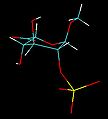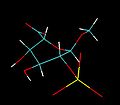Iduronic acid
| File:IduronicAcid-chair.png | |
| File:IduronicAcid.png | |
| Names | |
|---|---|
| IUPAC name
(2S,3R,4R,5S)-2,3,4,5- tetrahydroxy-6-oxohexanoic acid
| |
| Other names
L-Iduronic acid, D-ido-Hexuronic acid, IdoA
| |
| Identifiers | |
3D model (JSmol)
|
|
| ChEBI | |
| KEGG | |
| MeSH | Iduronic+acid |
PubChem CID
|
|
| |
| Properties | |
| C6H10O7 | |
| Molar mass | 194.139 g/mol |
Except where otherwise noted, data are given for materials in their standard state (at 25 °C [77 °F], 100 kPa).
| |
L-Iduronic acid (IdoA) is the major uronic acid component of the glycosaminoglycans (GAGs) dermatan sulfate and heparin. It is also present in heparan sulfate although here in a minor amount relative to its carbon-5 epimer glucuronic acid.
IdoA is a hexapyranose sugar. Most hexapyranoses are stable in one of two chair conformations 1C4 or 4C1. L-iduronate is different and adopts more than one solution conformation, with an equilibrium existing between three low energy conformers. These are the 1C4 and 4C1 chair forms and an additional 2S0 skew-boat conformation.
IdoA may be modified by the addition of a O-sulfate group at carbon position 2 to form 2-O-sulfo-L-iduronic acid (IdoA2S).
When internally positioned within an oligosaccharide the 1C4 and 2S0 conformations (shown below for IdoA2S) predominate.
Proton NMR spectroscopy can be used to track changes in the balance of this equilibrium.[1]
-
IdoA(2S)1C4 conformation -
IdoA(2S)2S0 conformation
References
- ^ Ferro, D. R. Provasoli, A. (1990). "Conformer populations of L-iduronic acid residues in glycosaminoglycan sequences". Carbohydr. Res. 195: 157–167. doi:10.1016/0008-6215(90)84164-P. PMID 2331699.
{{cite journal}}: CS1 maint: multiple names: authors list (link)


